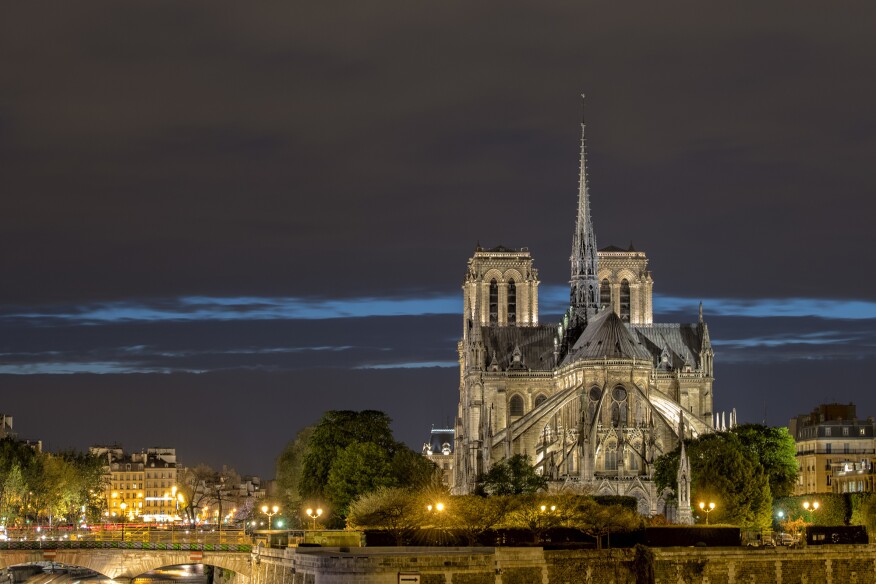
How should we rebuild Notre Dame? The answer should seem simple: exactly as it was. Like all buildings that have some age on them, however, the Church of Our Lady in Paris is not exactly a virgin, and figuring out what and how to restore a building that has seen bouts of construction for over six centuries is an open question. Most notably, the part (the roof and spire) that burned down on April 15 was mainly the (re)creation of medieval ideas as imagined by the architect Eugène Viollet-le-Duc in 1844.
Luckily, the French authorities are more on the ball than most critics and commentators, most of whom have conveniently left the malleability of the originality of this particular building out of their laments. The Culture Ministry has already announced an international competition to reconstruct or replace Viollet-le-Duc’s spire and roof, which most people assume has been there since the Middle Ages. Whether or not that initiative will truly open itself up to anything but a redo of what has been, in the last century-and-a-half, an integral part of how we perceive Notre Dame, remains to be seen.

Faut-il reconstruire une flèche ? À l’identique ? Adaptée aux techniques et aux enjeux de notre époque ? Un concours international d’architecture portant sur la reconstruction de la flèche de la cathédrale sera organisé. #NotreDame
— Edouard Philippe (@EPhilippePM) April 17, 2019
"Should we rebuild an arrow? The same? Adapted to the techniques and challenges of our time? An international architectural competition for the reconstruction of the Cathedral Spire will be organized. #NotreDame" (translation into English from Twitter)
Notre Dame was, because of its place in France and French culture, without any doubt the most important descendent of Abbé Suger’s Gothic prototype, Saint-Denis. The semi-mythical inventor of the French Gothic might have inspired more elegant churches, and some of them certainly conform more closely to what we know were his intentions, but the sheer scale and the position of Notre Dame makes it the emblem of that style.
The cathedral’s exterior is, to be honest, not nearly as impressive as its interior. The two towers of the “westwork,” or entrance façade, are not symmetrical and never received their spires. It is the statuary that gives them their character. Most of the church’s body is visible only in glimpses from afar or close. Its most coherent proclamation of faith is that 300-foot-tall spire, Viollet-le-Duc’s re-creation of the original, based both on records and on parallels in other churches. Viollet-le-Duc was also responsible for the reconstruction of the wood roof and the sacristy.

It is the cathedral’s interior that really soars, and that has largely survived the fire. To my surprise, even the stained glass, including the glorious rose window to the east, appear to be largely intact. Most of the bronze statues had also been removed for restoration. In fact, I wonder why there are estimates that the work might cost over a billion euros, as “all” that was destroyed was that superstructure (there is also some damage from the roof falling in over the nave).
The bigger discussion, then, is about what should be reconstructed, how, and why. Most of the medieval and renaissance-era cathedrals we see today are either largely 19th-century re-creations or collages of building campaigns from various eras. While the re-creations or extrapolations—Cologne Cathedral being the most notable—have the advantage of creating a unified impression, the places of worship that have been built up over the centuries have the advantage of offering a variety of different experiences and perspectives on faith and communal devotion. Even Cologne now has a very effective stained-glass addition created by the living artist Gerhard Richter.
If the choice is to either re-create Viollet-le-Duc’s channeling of Suger, or to try to go back, using current science and archival research, to do so in an even more “correct” manner, the main question is whether we should stop there, or try to do a better job not only in reconstructing the roof, but also in finishing the twin towers and other elements of the medieval design (at least as far as we can know it).
If the choice, on the other hand, is to invent something new, what should that be? The internet has filled up with the usual jokes, memes, and half-serious visions that range from domes to a statue of our current Madonna (Ciccone) replacing the spire. I am not sure what a 21st-century spire and roof would look like but know that it would have to both avoid copying and a sense of being an alien object dropped into a well-worn and well-honed icon. The trick would be to figure out what is essential about Suger’s principles and style, and then find a way to realize those ideas and forms without directly copying the copy that was there.
But we also have to ask what not only Catholicism but the notion of an iconic object in a multicultural and therefore multireligious city such as Paris means for architecture, and how current technologies and materials influence the development of form. If anyone can answer that knot of questions, they might come up with a design that continues the work of faith that has made Notre Dame such a majestic object, tested by time and now fire, that keeps acting as a symbol and a fact of faith.
When I was still in high school, I found myself at Notre Dame on Christmas Eve, and attended the midnight mass there. The archbishop and all the other ecclesiastical grandees marched in, the choirs sang, the incense filled the nave so that its ceiling disappeared into mist, and I felt as if I had been transported, even as a pagan, into another place and time. If whatever is built now manages to capture and strengthen that sense of transcendence, it will be worth it.
















